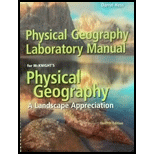
To compare: Mountain glaciers and continental ice sheets.
Answer to Problem 1LC
Mountain glaciers are found high in a mountainous valley while the continental ice sheets extend over the continental landmass such as Greenland. Mountain glaciers are only found in high-mountain tops whereas the continental ice sheets are found at the Earth’s poles regardless of the elevation.
Explanation of Solution
Glaciers are moving mass of ice under the influence of gravity.
- A. MOUNTAIN GLACIERS
There are two kinds of mountain glaciers, highland ice fields and alpine glaciers.
- a) Highland Icefield is an unconfined ice sheet in high-mountainous regions, which evolve into valley glaciers and piedmont glaciers. These ice sheets cover hundreds or thousand square kilometers.
1. Valley glacier is a long and narrow river of ice that is spilling out of its originating basin and travels down to the valley.
2. Piedmont glacier is a valley glacier that reaches to the valley mouth and fans out extensively over the flat land beyond the confining valley walls.
b) Alpine glacier – An individual glacier forms adjacent to a mountain crest line and normally moves down the valley for some distance. They usually form at the heads of the valleys. An alpine glacier typically originates out of its basin and flows down-valley by forming a valley glacier, and can also reach the valley mouth and give a piedmont glacier.
- 1. Cirque glacier is a small alpine glacier confined to its cirque basin and does not move down to the valley.
- B. CONTINENTAL ICE SHEETS
- a) Ice sheet – A massive blanket of ice that completely engulfs the landmass underneath about hundreds or thousands of meters depth. The depth of the ice sheets are greater in its interior and thin out at the outer edges. These are formed in non-mountainous areas of continents. There are only two true ice sheets currently, in Antarctica and Greenland.
- b) Outlet glacier - A long tongue-like feature of ice around the edges of an ice sheet that extends between rimming hills to the sea. Ice shelf is a shelf of ice that is reaching the ocean that protrudes over the sea along a massive front. Icebergs are formed from calving of ice chunks from ice shelves and outlet glaciers.
Want to see more full solutions like this?
Chapter 19 Solutions
Physical Geography Laboratory Manual (12th Edition)
- Discussion Question: Ecosystems Essentials A+ shof 1000 Exo-spil The Human Denominator Assignment As we learn about how the earth works, we learn to identify the different earth spheres and how they overlap and affect one another. An understanding of the Earth's systems and spheres takes practice. More importantly, we can see the "Domino Effect" of the spheres as they interact with one another. We have learned that while endogenic processes are separate from exogenic process, the lithosphere affects the atmosphere which affects the hydrosphere, and thearrow_forwardI need help with part c and darrow_forwardI need help with tracing over part A can someone help me outarrow_forward
- I need help with question 3 can someone help me.arrow_forwardI need help with tracing part A could I get some helparrow_forwardActivity 12.3: Wave Refraction Pgs 202-203Figure 12.2 is a map view of a headland along a coastline. The water depths are shown by blue contour lines. As you complete the following questions, assume that waves with a wavelength of 60 feet are approaching the shoreline from the bottom left of the figure. 1. At approximately what water depth-10, 20, 30, or 40 feet-will the approaching waves begin to touch bottom and slow down? (Hint: Recall that this occurs when the water depth is one-half the wavelength.) Approximately the 30-foot depth line. 2. Using the wave shown in Figure 12.2 as a starting point, sketch a series of lines to illustrate the wave refraction that will occur as the wave approaches the shore by following these steps:Step 1: Mark the position on the 30-foot contour line where the wave front will first touch bottom.Step 2: Knowing that the section of the wave that touches bottom will slow down first, sketch the shape of the wave front when it reaches the 20-foot contour…arrow_forward
- N Depth of water contour Advancing wave crest Beach HEADLAND -10'- 20'- -30- Land -40- -50'- 0 Beach Scale 200 feetarrow_forwardI need help on Part C question 2arrow_forwardcan you please show me the drawings for each of these i want to make sure I have them right, as well as explaing the answers, thank youarrow_forward
- I need help on Part Carrow_forwardI need help with part a and barrow_forwardIn fig A13.2.3, what are the gradient and sinuosity of Passage Creek from G and G? Refer to figs. 12.3 and 12.4 for help measuring gradient and sinuosity. Show your calculations. You will graph it later in the activity. Gradient: ______ ft/mi Sinuosity:arrow_forward
 Applications and Investigations in Earth Science ...Earth ScienceISBN:9780134746241Author:Edward J. Tarbuck, Frederick K. Lutgens, Dennis G. TasaPublisher:PEARSON
Applications and Investigations in Earth Science ...Earth ScienceISBN:9780134746241Author:Edward J. Tarbuck, Frederick K. Lutgens, Dennis G. TasaPublisher:PEARSON Exercises for Weather & Climate (9th Edition)Earth ScienceISBN:9780134041360Author:Greg CarbonePublisher:PEARSON
Exercises for Weather & Climate (9th Edition)Earth ScienceISBN:9780134041360Author:Greg CarbonePublisher:PEARSON Environmental ScienceEarth ScienceISBN:9781260153125Author:William P Cunningham Prof., Mary Ann Cunningham ProfessorPublisher:McGraw-Hill Education
Environmental ScienceEarth ScienceISBN:9781260153125Author:William P Cunningham Prof., Mary Ann Cunningham ProfessorPublisher:McGraw-Hill Education Earth Science (15th Edition)Earth ScienceISBN:9780134543536Author:Edward J. Tarbuck, Frederick K. Lutgens, Dennis G. TasaPublisher:PEARSON
Earth Science (15th Edition)Earth ScienceISBN:9780134543536Author:Edward J. Tarbuck, Frederick K. Lutgens, Dennis G. TasaPublisher:PEARSON Environmental Science (MindTap Course List)Earth ScienceISBN:9781337569613Author:G. Tyler Miller, Scott SpoolmanPublisher:Cengage Learning
Environmental Science (MindTap Course List)Earth ScienceISBN:9781337569613Author:G. Tyler Miller, Scott SpoolmanPublisher:Cengage Learning Physical GeologyEarth ScienceISBN:9781259916823Author:Plummer, Charles C., CARLSON, Diane H., Hammersley, LisaPublisher:Mcgraw-hill Education,
Physical GeologyEarth ScienceISBN:9781259916823Author:Plummer, Charles C., CARLSON, Diane H., Hammersley, LisaPublisher:Mcgraw-hill Education,





